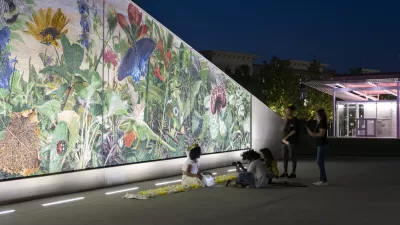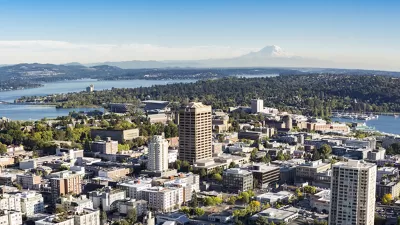Current planning practices can alienate some voters, which contributed to Donald Trump’s success in the recent US election. How have planners contributed to this problem, and how can we achieve more responsive and inclusive planning?

I was personally disappointed by Donald Trump’s selection as president. I believe that his policies will be harmful, regressive, and undemocratic, and that many of his supporters voted against their own self-interest. But, to be honest, planners may have contributed to his success with practices that alienate white, lower-income and rural voters. Below are examples, and suggestions for more responsive and inclusive planning.
Environmental Priorities
The planning profession tends to attract people who are personally concerned about environmental quality, so many of us work to keep environmental protection high on the policy agenda. Although well intended, this can alienate citizens who have other priorities.
For example, I recently heard a conference presentation by technical experts about their municipal greenhouse gas (GHG) reduction study. Because motor vehicles are the primary emission source in that city, their analysis focused on identifying local development policies that would reduce vehicle-travel and therefore emissions. Based on this analysis, the experts recommended that the city achieve much more compact development.
This many seem reasonable to people who are very concerned about climate change, but to citizens with other priorities it sounds like planners want to severely restrict residents' housing and travel options in order to achieve their own goals. The more we argue about the importance of reducing GHG emissions, the more disconnected and elitist we seem.
There are better approaches. Compact development can provide many direct benefits to residents and local businesses. In addition to modeling GHG emissions, these planners could also have measured:
- Transportation costs, and described compact development as consumer savings and affordability strategy.
- Crash rates, and walking and cycling activity, and described compact development as a way to increase community safety, public fitness and health.
- Modeled non-automobile accessibility, and described compact development as a way to increase non-drivers' freedom and independence, and therefore support aging in place.
- Local business and employment impacts, and described compact development as economic development strategy.
Modeling these additional impacts would require little extra effort, and doing this could fundamentally change the political dynamics by offering stakeholders with diverse priorities good reasons to support compact development. Rather than portraying compact development as a policy forced on communities, it can be considered a way to respond to growing consumer demand for housing in walkable, mixed, and vibrant neighborhoods.
Housing Policy
Housing and transportation are the largest two expense categories for most households, and are particularly burdensome to lower-income households. On average, the lowest income quintile (fifth of households) spends 40% of its budget on housing and 15% on transportation, leaving little money for other important goods. If lower-income households cannot afford healthy food or healthcare, the actual cause is usually high housing and transportation costs, since for each dollar spent on food and healthcare they typically spend three to five dollars on housing and transport. Increasing the supply of affordable housing in accessible, multi-modal neighborhoods can reduce lower-income households’ financial stress.
Many communities have housing affordability programs, but not all households benefit, and some strategies can harm, and therefore alienate, moderate-income households. There are two general approaches to increasing housing affordability. Some programs provide subsidies or below-market housing to selected households. Planners often prefer this approach because they can determine exactly who benefits, and by how much. However, such programs generally only serve a small portion of affordable housing demand, and strategies such as inclusionary mandates (developers must sell or rent a portion of units below market prices) tend to increase the costs of the non-subsidized units. Similarly, in areas with a limited supply of low-priced rental units, providing rent vouchers to one group, such as people at risk of homelessness, will displace other groups that need affordable housing such as students, low-wage workers and pensioners. These targeted programs may seem unfair to moderate income residents who do not qualify for special housing assistance.
A more inclusive way to increase housing affordability is to encourage more lower-priced infill development, for example, by allowing higher densities, multi-family housing in residential neighborhoods, and reducing parking requirements. These structural reforms can significantly increase lower-priced housing supply, which provides savings to many low- and moderate-income households, including many who are excluded or harmed by subsidy-based housing policies.
Social Equity and Environmental Justice
Many government and planning organizations have environmental justice (EJ) programs intended to ensure that their activities are fair and equitable. Environmental justice was originally concerned with environmental racism, such as excessive pollution in minority communities, but their scope has expanded to include all types of social equity issues. For example, the U.S. Federal Highway Administration has an Environmental Justice Strategy, and the Transportation Research Board has an Environmental Justice Committee (of which I am a member), which is responsible for most social equity issues.
Equity tends to be difficult to evaluate [pdf] because there are multiple ways to define fairness, many impacts to consider, and various ways to categorize people. As discussed in a paper I co-wrote, "A New Social Equity Agenda for Sustainable Transportation" [pdf], the environmental justice programs implemented by government agencies can have significant limitations:
- They tend to respond to organized and concentrated groups, but not disorganized and dispersed groups. For example, bicyclists tend to be more politically organized and influential than the larger group of people who rely on walking, and minority groups tend to receive more consideration if they are geographically concentrated than if the same people are dispersed.
- They often use ambiguous classifications, such as race and age, as surrogates for functional status, such as poverty and physical disability. For example, although African Americans tend to have high poverty rates, it is wrong to assume that all African Americans are poor, and unfair to overlook white poverty. Similarly, although seniors tend to have high disability rates, it is wrong to assume that all seniors are disabled, and unfair to overlook the needs of younger disabled people. Yet, senior, including those with high incomes, often receive discounts on public transportation and ferries, and even taxi subsidies, although other groups, such as moderate income families with children, have greater needs.
- They tend to consider social equity issues in isolation, and so favor special mitigation actions rather than more integrated solutions that may help achieve more total benefits. For example, social equity programs often support special mobility programs or targeted subsidies to benefit certain disadvantaged groups, but seldom support broad reforms to improve affordable housing and transportation options overall, although this could benefit a much larger group of disadvantaged people, such as moderate income households and young people who cannot drive.
More inclusive planning focuses less on categorical factors such as race, ethnicity, and age, and more on functional factors such as physical ability, income, and geographic isolation. This would give greater recognition to the disadvantages faced by groups such as rural non-drivers, low-income whites, and adolescents.
Multi-Modal Transportation Planning
Most cities have a various programs intended to help improve and encourage transportation options, including cycling plans, transit improvement programs, and subsidies for new transportation services such as ridesharing, although they serve a small portion of travel. Walking, cycling, and public transit are promoted as "green" and "sustainable" while driving is criticized. Such planning can contribute to the feeling that special interest groups receive excessive consideration to the detriment of motorists, sometimes called a "war on cars."
There is a little truth and a lot of exaggeration in such criticism. It is true that walking, cycling and public transit generally have modest mode shares, but it is also true that they play unique and important roles in an equitable and efficient transportation system, and that improving these modes can provide many benefits, including indirect benefits to people who do not currently use them but experience reduced traffic and parking congestion, reduced chauffeuring burdens and increased traffic safety, and who may need these options sometime in the future when they cannot drive.
Here are three specific ways that planners can help build broader support for multi-modal planning.
- We can do a better job of communicating the full economic, social, and environmental benefits of a more diverse transportation system, with special emphasis on "external" benefits to non-users. We may assume that alternative mode benefits are obvious that they don't need to be articulated, but they do! For example, it is insufficient to simply say that walking, cycling, and public transit should be encouraged because they are "green." We need to show how they can help reduce parking problems, save consumers money, improve public fitness and health, and support local economic development.
- We can rely less on special modal plans, and instead make integrated multi-modal transport plans, so walking, cycling, and public transit improvements are integrated into all planning activities. Complete Streets policies are an excellent approach; they emphasize that all roads should accommodate diverse uses and users, including walking, cycling, automobile, and public transit, plus nearby businesses and residents. Similarly, better streetscaping and roadway design are also ways to incorporate multiple modes and planning objectives into transport planning.
- We can be smarter when comparing modes. As discussed in my column, "A Trillion Dollars, Or Cents Per Day," if you want to make something seem expensive, report its total lifetime costs, but if you want to make it seem cheap, report its unit costs compared with other similar goods. In general, the best way to present any economic impact is measured annual per capita. For example, I recently completed a study that identified options for raising $6 billion to finance Nashville, Tennessee region public transit improvements. Described that way, the program seems costly, but we also described it as "approximately $110 annual per capita, of which about $60 is local funding," which allows people to compare this with other expenditures, such as road and parking facility costs, and the costs of owning and operating a typical car. Considered this way, a $60 annual tax increase is cost-effective if it would reduce automobile expenditures by just 1 percent.
Summary
Skeptical readers might point out that most of the planning activities described in this column occur at the local or regional level, and do not directly affect federal politics, but few citizens make that distinction. Many people consider "the government" a single entity, and local planning activities are their most common interaction with government decision-making. As a result, we are the face of government. Planners generally try to be responsive and inclusive, but the recent presidential election is a reminder that we must do even better to address some citizen’s alienation.
For more discussion of this issue, see Nancy Holman's Like Mixing Oil and Water?: The Take up of Sustainability in Hard-to-reach Places - an East Texas Case Study, and Andrew Whittemore's Finding Sustainability in Conservative Contexts: Topics for Conversation between American Conservative Elites, Planners and the Conservative Base.
What do you think? How can planners be more responsive and inclusive?

Planetizen Federal Action Tracker
A weekly monitor of how Trump’s orders and actions are impacting planners and planning in America.

Maui's Vacation Rental Debate Turns Ugly
Verbal attacks, misinformation campaigns and fistfights plague a high-stakes debate to convert thousands of vacation rentals into long-term housing.

San Francisco Suspends Traffic Calming Amidst Record Deaths
Citing “a challenging fiscal landscape,” the city will cease the program on the heels of 42 traffic deaths, including 24 pedestrians.

Amtrak Rolls Out New Orleans to Alabama “Mardi Gras” Train
The new service will operate morning and evening departures between Mobile and New Orleans.

The Subversive Car-Free Guide to Trump's Great American Road Trip
Car-free ways to access Chicagoland’s best tourist attractions.

San Antonio and Austin are Fusing Into one Massive Megaregion
The region spanning the two central Texas cities is growing fast, posing challenges for local infrastructure and water supplies.
Urban Design for Planners 1: Software Tools
This six-course series explores essential urban design concepts using open source software and equips planners with the tools they need to participate fully in the urban design process.
Planning for Universal Design
Learn the tools for implementing Universal Design in planning regulations.
Heyer Gruel & Associates PA
JM Goldson LLC
Custer County Colorado
City of Camden Redevelopment Agency
City of Astoria
Transportation Research & Education Center (TREC) at Portland State University
Jefferson Parish Government
Camden Redevelopment Agency
City of Claremont






























